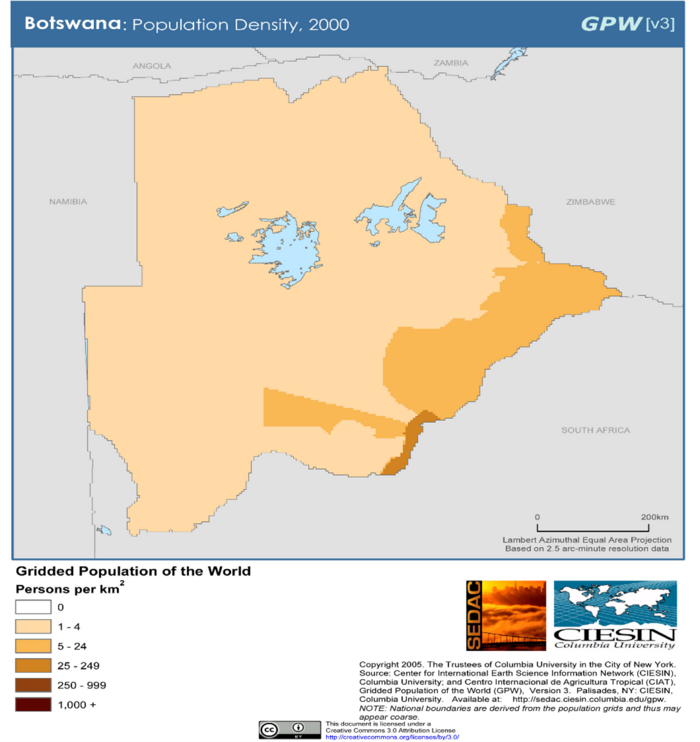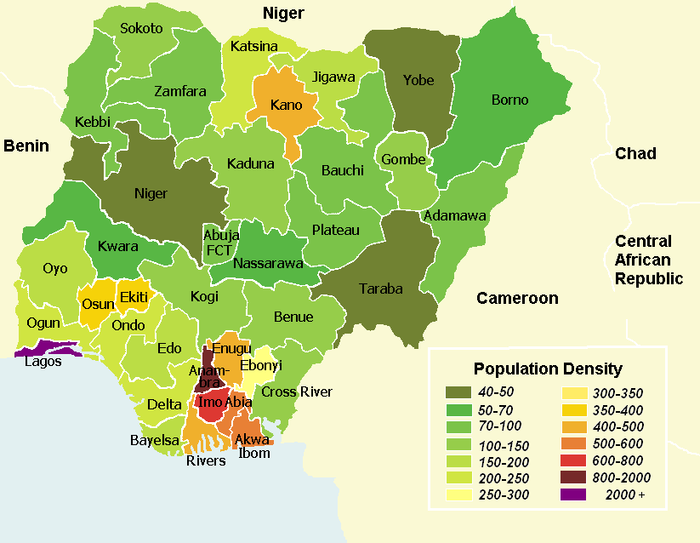In any given context, there is an interplay of factors that creates a conducive environment for the success of distance education. These factors operate at macro level, like national; at meso level, like provincial or district and at micro-level, like institutional or even programme level.
Macro Factors
This activity should take you about 15 – 20 minutes to complete.
Figure 3.1 below shows the map of Botswana, one of the Southern African countries which has successfully implemented ODFL at various levels in the education system.
Fig. 3.1 Map of Botswana

CC BY Source: https://www.flickr.com/photos/54545503@N04/6172434176
Study the map and identify possible challenges likely to be faced at national level in providing ODFL.
- What challenges are faced (or are likely to be faced) at national level in rolling out successful ODFL?
- Share your ideas in the discussion forum and read at least one other post.
Feedback and comment on Activity 3
In your answer to the first question above, you may have identified challenges that have to do with the uneven distribution of population in Botswana. For example, half the country size has an average population density of less than 1 person per square kilometre. This is because the greater part of the country is a desert. This makes it difficult for government to establish essential infrastructure and facilities that create a favourable environment for ODFL. For example, reaching the sparsely populated communities with road, telephone and internet fibre networks is not cost-effective. The irony is that it is often people who live in such isolated and spatially distributed conditions who need ODFL most. The biggest concern therefore is that it remains difficult and in fact, very costly to reach out to these people even through distance education. In this context, ODFL institutions go out of their way to devise means of ensuring that these marginalised communities access education.
Another concern often raised at national level is lack of a (clear) distance education policy. Such a policy gap usually leads to uncertainty by the public on the comparability of qualifications obtained through distance education with those obtained through traditional institutions. In some contexts, lack of policy to facilitate mainstreaming of distance education has disadvantaged people who study through this mode of provision when it comes to opportunities for furthering their education or accessing jobs. Linked to policy is also the concern about the parity of distance education curricula with conventional ones, which affects articulation and student advancement.
A factor linked to policy is funding of ODFL at national level. Where there is no policy on distance education, public funding has either been absent or has been too little to make significant impact in terms of this mode of provision. In either case, this has such negative repercussions like poor resourcing of ODFL, limited access due to lack of support for the poor people, and generally poor quality of provisioning leading to negative perceptions of this mode of provision by the public.
What other challenges did you think of that operate at national level in your context? What other challenges did you read about in the chat?
Meso Factors
Here, think of meso factors as those that operate at provincial or district level. You saw how extreme low population density in the desert parts of Botswana can be a challenge in ODFL provisioning. The map below shows the population densities of various provinces (states) in Nigeria.
Figure 3.2: Population density map of Nigerian states

CC BY SA https://en.m.wikipedia.org/wiki/File:Population_density_map_of_Nigerian_states_-_English.png
Nigeria is the opposite of Botswana in terms of population size. Whilst the latter has a total population of just over 2.3 million, the former has a population size of 226.2 million. Of course, this makes ODFL quite attractive at national level as formal educational institutions would never be enough to meet the high demand. However, if you look at the State of Ogun and Lagos in particular, you will see that the population density is 250-300 and over 2000 persons per square kilometre respectively. Obviously, this poses insurmountable challenges in terms of providing facilities and adequate systems for distance learners. For example, because examinations are still campus –based, securing venues that can accommodate the large numbers of candidates is a huge challenge. Before learning materials were digitised, the cost of printing and the logistics of distributing the materials to learners were also daunting tasks. Thanks to the astute planning and management acumen of the institution, and the availability of enabling technology, these challenges have since been addressed by leveraging on the affordances of technology.
So, what the Botswana and Nigerian examples show is that extremes of population densities have potential to pose challenges not only in reaching everyone through traditional face-to-face education, but also in providing high quality ODFL.
Similar conditions are experienced in the Pacific Island countries where there are many remote islands dotted over vast ocean waters, some with only a handful of inhabitants.
What are the challenges that are faced in rolling out ODFL in Pacific Island countries?
Micro Factors
As highlighted above, think of micro factors as those that operate at institutional or even at academic programme level.
If you offer ODFL in your institution or in your country, you should be able to identify these factors quite easily. You are requested to do that in Activity 4 below.
This activity should take you about 15 – 20 minutes
- Identify and list five key challenges of rolling out ODFL at your institution or at an ODL institution you are familiar with.
- Share one challenge in the chat and respond to a different challenge put forward by another student.
Feedback and comment on Activity 4
Read the following section and compare with your answer to Activity 4 above.
Rolling out distance education at an institution can be a complex process with various challenges. Some common challenges include:
- Technological Infrastructure
- Access and Connectivity: Ensuring that students and faculty have access to reliable internet connections and appropriate devices can be a significant challenge, especially in regions with limited infrastructure. The example given above of the desert areas of Botswana is a case in point.
- Technical Support: Providing adequate technical support for users who may encounter issues with online platforms, software, or hardware is crucial for a smooth distance education rollout. This problem is very common in most developing contexts; it is probably applicable to your context as well.
- Pedagogical Shift
- Faculty Training: Faculty members may need training to adapt their teaching methods to the ODFL environment. This includes supporting distance learners using virtual learning tools, online discussions, and creating engaging digital content.
- Curriculum Adaptation: Adapting existing courses or creating new ones that are suitable for ODFL using a particular delivery model requires careful consideration and planning.
- Student Engagement and Motivation
- Lack of Face-to-Face Interaction: Distance education may lack the face-to-face interaction that traditional classrooms offer, potentially leading to decreased student engagement and motivation, and sometimes even frustration and dropout.
- Isolation: Students might feel isolated when studying remotely, and maintaining a sense of community can be challenging.
- Assessment and Integrity
- Ensuring Academic Integrity: Preventing cheating and plagiarism in ODFL, especially in online assessments can be more challenging than in traditional settings. Institutions need to implement effective measures to maintain academic integrity.
- Assessment Methods: Designing fair and effective online assessments that accurately measure student understanding is a key consideration.
- Regulatory and Accreditation Compliance
- Meeting Standards: Institutions must ensure that their distance education programs meet the regulatory and accreditation standards set by relevant education authorities. This may involve navigating complex compliance requirements.
- Resource Allocation
- Financial Resources: Implementing a distance education programme may require significant financial investments in technology, training, and support services.
- Time and Personnel: Adequate time and personnel are necessary for the successful implementation and ongoing maintenance of distance education programmes.
- Accessibility and Inclusivity
- Accessibility Standards: Ensuring that the online learning materials and platforms comply with accessibility standards is essential to accommodate students with diverse needs.
- Inclusivity: Institutions need to consider how to make distance education inclusive for all students, including those with disabilities or different learning styles.
- Data Security and Privacy
- Protecting Student Data: Implementing robust security measures to protect students' personal and academic information is critical to comply with privacy regulations and build trust.
- Addressing these challenges requires careful planning, collaboration among stakeholders, and a commitment to continuous improvement based on feedback and evolving best practices in distance education.24

